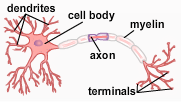Chapter 1. Neural Communication
1.1 Neural Communication
Each neuron is a tiny decision-making device, designed to receive informational input from many other neurons and calculate whether or not to output a response.
The vast majority of neural signals are initiated by excitatory chemicals.The most common excitatory chemicals are neurotransmitters released from adjacent cells.
Chemical excitation of a neuron typically occurs at the dendrites, which contain a high concentration of chemical receptor sites made up of proteins.
If the stimulation exceeds the neuron's threshold (trigger point), the neuron generates a brief electrical impulse. Excitatory chemicals simulate a change in electrical potential across the cell membrane. When this happens on the dendrite small electrical charge moves along the the dendrite membrane to the cell body, along the cell body membrane to the axon , and then down the length of the axon membrane to the axon terminal. The excitatory electrical charge that travels down the axon to the terminal has the potential to stimulate chemical release from that reason.
If an excitatory chemical is released, the transmission process described here may be repeated on the next neuron.
1.2 Neural Communication
Most of the messages a neuron receives are excitatory signals that increase the likelihood that the neuron will generate its own message. But some are inhibitory signals that make it harder for the neuron to fire—blocking the effect of the excitatory signals.
Why does the communication system need inhibitory signals? Rather than responding to every message, the neuron can respond selectively to only those situations in which the balance between excitatory and inhibitory signals tips toward excitation.
This leads to better decision making and finer control of behavior.
1.3 Neural Communication
If the ratio of excitatory and inhibitory signals causes the neuron to respond by generating its own neural impulse, this impulse then moves down the axon to the axon terminals. At each terminal, the impulse triggers the release of chemical messengers called neurotransmitters.
1.4 Explain. Neural Communication

Neurons are the building blocks of the nervous system. Each neuron consists of a cell body and its branching fibers. The bushy dendrite fibers receive information and conduct it toward the cell body. From there, the axon passes the message along to other neurons or to muscles or glands. The process of neural communication begins when a neuron is stimulated by chemical messages from neighboring neurons. Most of these messages are excitatory signals that increase the neuron's ability to "fire" (generate a neural impulse), but some are inhibitory signals that block the excitation. The neural impulse, called the action potential, is a brief electrical charge that travels down the axon. When the action potential reaches the knoblike terminals at the axon's end, it triggers the release of chemical messengers called neurotransmitters. Within a fraction of a second, the neurotransmitter molecules cross the synaptic gap and stimulate the next neuron.
1.5 Question
QUESTION: Which of the following descriptions provides an overview of neural communication?
1.6 Question
QUESTION: Which of the following descriptions correspond to release of neurotransmitter molecules?
1.7 Question
QUESTION: Which of the following descriptions shows synaptic vesicles migrating toward the axon membrane?
1.8 Question
Indicate whether the statement is true or false.
QUESTION: The neural communication process usually begins when an axon receives signals from other nearby neurons.
1.9 Question
Indicate whether the statement is true or false.
QUESTION: Excitatory signals make it more likely that a neuron will generate its own electrical impulse.
1.10 Question
Indicate whether the statement is true or false.
QUESTION: When the message reaches an axon terminal, an electrical impulse travels across the synaptic gap and stimulates the next neuron.
1.11 Question
Indicate whether the statement is true or false.
QUESTION: Inhibitory signals can block the effect of excitatory signals, reducing the likelihood that the neuron will fire.